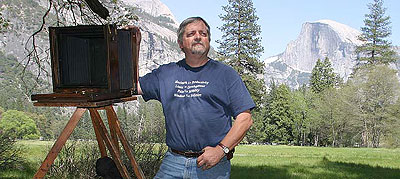

|
| Will Dunniway lived in Southern California in the old orange growing town of Corona. Will has been a graphic artist and photographer for 35 years and a student of American History for most of his adult life.
He came into contact with the wet plate collodion process while re-enacting the 125th Anniversary of the Battle of Gettysburg back in 1988. He watched with fascination as John Coffer and Claude Levet worked their collodion magic making Tintypes and Ambrotypes of the re-enactors there. He knew right there and then that he was watching the perfect blend of his abilities and interests. He talked with John and in the summer of 1990 apprenticed under him and later under Claude Levet. In the 14 years that followed, Will has become an expert in this historic collodion photographic process. He has taught the process at college photographic classes and various historical institutions including the State of California. On one occasion he produced red class Ambrotypes of Winona Ryder and other props for movie director, Francis Ford Coppola's 'Dracula' production. In some of the images in his web site Dunniway walks through Yosemite Valley in the footsteps of photography's early pioneers, capturing the waterfalls and surrounding area where things have remained almost unchanged from long ago. Other views capture beautiful coastal scenes, coastal lighthouses, and images of the Santa Rosa Plateau in Wildomar. Using mid-nineteenth century techniques and equipment Dunniway makes mirror images of those taken 150 years ago. This process known as wet plate photography or Collodion photography was created in England in 1851 by Francis Scott Archer. It involves an ordinary glass plate coated with this now light sensitive liquid emulsion. The photograph is taken and immediately developed while still wet. The camera, thoroughly stained black in places from the chemicals used to bring images to life, is brought to a location, where it is placed on a tripod and the brass barreled lens is attached. This setup already speaks of history long past. The English-made lens, is proudly engraved on the barrel with its maker's name, which brings to mind memories of the Victorian age. Dunniway says, with a sparkle in his eye, "You have to really want to do this. . . it is not easy. My tools involve a very heavy, civil war era camera with bulky lenses, and dangerous chemicals. The 'film' comes in the form of a 20 lb box of 8x10 glass." In Dunniway's images one sees many waves, ripples, pours, and movements captured as the slow puddles and drips are superimposed against the image captured by the antique lens, which simultaneously creates sharpness and softness. Thus the image, when developed, is much more than just a record of what was in front of the camera. . .it is juxtapositioned upon a tissue-thin seascape of emulsion as it freezes time. We simultaneously see time slowing and stopped in two different worlds. . .two stories brought together. These sublime images reach across 3 different centuries and tell us about a time past, but newly examined and interpreted. "My work is about beautiful natural things, with a sensibility of the 19th century eye, but layered in new meaning for the 21st century viewer." In the 19th century, when this camera was birthed amid so much death and anger in America, many of the famous photographers of the time like Timothy O' Sullivan, Carelton Watkins and William Henry Jackson were turning toward landscape, and the great American West seemed vast and wild as opposed to the destruction taking place in the East. Now, in the 21st century, Dunniway approaches some of these same subjects, seeing the west as tamed and vanishing. . .a geographical heritage becoming as rare as the equipment he shoots with. "The interplay of old glass, chemicals, wood, brass, weather, and immediacy of development is a dance, a rhythm. . .a flow, mixed with luck and sweat speaking about the past, present and to the future. . .is wonderful to me. This is a language modern photography, for the most part, no longer speaks. I am not threatened by digital cameras, as many traditional photographers are, I recall a time when others like myself were seeing this new thing called "film" and worrying about the end of their craft. 'Modern' and 'technology' are relative terms that speak more about the society that created them than the actual devices themselves. To me, the dialog between old and new, film and digital, silver gelatin and ink jet, is largely irrelevant. What is real to me is when the pouring of collodion on glass comes together with the capturing of an image inside an old box made of wood, glass, and cloth. It's then I feel a kinship with those who have come and gone long before I walked the earth." |
|
